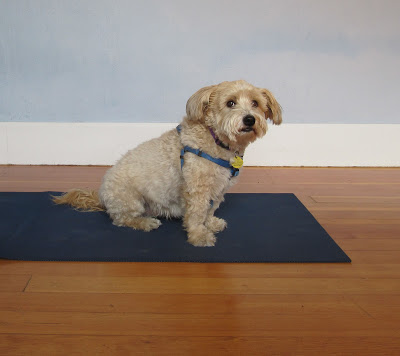by Baxter
 |
| Agile Mugsy Pretending to be Baxter |
This past weekend, Nina and I taught our first official “Yoga for Healthy Aging” workshop together in Castro Valley, CA, just a short 25 minute jaunt from Oakland. As we were preparing for the session, we discussed some essential skills or benefits that regular asana, pranayama and meditation practice can lead to for those of us concerned with aging well. Some of the more obvious benefits include improved flexibility and mobility of muscles and joints, improved strength and improved balance. But another result that requires a combination of the previous three benefits is improved agility. And although I will be referring to mainly physical agility, experience also points to improved mental agility as a bi-product of regular practice as well.
If you search “agility” on Google, most of the first hits are about our favorite four-legged friends, dogs (down, you cat lovers!). It turns out there are actual courses you can enroll your dog in to improve his or her agility! In many ways, our yoga practice does the same for us two legged creatures! So get yourself enrolled soon if you are not already.
So, what does “agility” entail? Well, in addition to flexibility, mobility, strength and balance, wikipedia expounds nicely on these and a few more components:
“Agility or nimbleness is the ability to change the body’s position efficiently, and requires the integration of isolated movement skills using a combination of balance, coordination, speed, reflexes, strength and endurance. Agility is the ability to change the direction of the body in an efficient and effective manner and to achieve this you require a combination of: balance – the ability to maintain equilibrium when stationary or moving (i.e. not to fall over) through the coordinated actions of our sensory functions (eyes, ears and the proprioceptive organs in our joints); static balance – the ability to retain the centre of mass above the base of support in a stationary position; dynamic balance – the ability to maintain balance with body movement; speed – the ability to move all or part of the body quickly; strength – the ability of a muscle or muscle group to overcome a resistance; and lastly, co-ordination – the ability to control the movement of the body in co-operation with the body’s sensory functions (e.g. catching a ball [ball, hand and eye co-ordination])”
What warms the cockles of my heart (what ever those are!) when I read this definition is how wonderfully a balanced yoga practice supports our ability to improve agility. We’ve referred to proprioceptors in past posts, and how mindful awareness of information coming from the joints to the brain allows us to master yoga postures, and improves our ability to know where we are in space and how fast we are moving. And with a good mix of held and dynamic yoga practices, we are cultivating balance and reducing the chance of falls, which, as many of you may know, are a leading cause of morbidity (increased chance of disease) and mortality (death) in the elderly. And by learning new sequences of postures, especially dynamic ones, as in vinyasa practices, your co-ordination is challenged and improved. I often like to make small changes in flow sequences like sun and moon salutes to continue to challenge students to be attentive and as a way of assessing the mental and physical nimbleness in making quick changes in a safe and effective way. And whether this translates into being able to quickly navigate a crowd or maintain your stationary balance on the crowded commuter train, agility means having one more beneficial tool to live a full life. And yoga delivers it!
Ready to try? You might do the following:
- Work daily on a few basic balancing poses, such as Tree, Half Moon, Warrior 3.
- When doing Sun Salutations at home, change your foot placement an inch or so as you step forward and back, and try to be precise at landing on your new mark.
- Look at your mix of static poses and dynamic sequences, and add in what is lacking of one or the other.
Until next time, zip, zip, zip…I’m outa’ here! (By the way, turns out cockles are small, edible saltwater clams! An allusion, no doubt, to the valves in our heart.)
Follow Yoga for Healthy Aging on Facebook ° To order Yoga for Healthy Aging: A Guide to Lifelong Well-Being, go to Amazon, Shambhala, Indie Bound or your local bookstore.


Leave A Comment